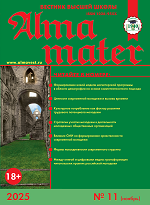UDC 378-042:004
https://doi.org/10.20339/AM.07-21.036
E.M. Zakharova is Cand. Sci. (Pedagogy), Ass. Prof. e-mail: mem229@mail.ru; and S.M. Bernikova is Senior Lecturer e-mail: svetlana_minina@mail.ru, both at Kurgan State University
Researched is the problem of implementing distance learning in the higher education system during the coronovirus pandemic. The results of a survey of 186 students of Kurgan State University studying in various scientific fields are considered. A comparative analysis of distance and full-time forms of education showed that half of the students of the humanities and mathematics/technical areas formed a positive attitude to the distance learning format; about a third of these students with a desire and the same number without a desire went to full-time form; they consider the ratio of 50/50% to be the optimal ratio of full-time and distance learning; and the quality of training and teaching, in their opinion, does not depend on the form of educational activity. Among the representatives of the natural science cycle, only 16% of students formed a positive attitude to distance learning and almost half of them (45%) were willing to go to full-time training; 51% believe that the motivation for learning is higher with full-time knowledge acquisition, and the optimal ratio of full-time and remote forms should be 70/30%; at the same time, in their opinion, the quality of education and teaching deteriorates in the distance. This is due, in our opinion, to the specifics of the disciplines studied. Most of the students of all training profiles (76–92%) are sure that it is easier to pass exams, pass border control, and pass certification remotely. 60–70% of all students experienced technical difficulties during the distance learning period. The main advantages of the distance form, according to students, are: the ability to study without leaving home (89–92%), in an individual mode, at a pace (88%); the ability to use hints (80–83%); no need to create a business image (78–86%). The main disadvantages: the lack of "live" communication (56–81%); technical problems (63–57%); reduced availability of material (40–70%); harm to health (40–50%), and others. The main advantages of the full-time form are: the presence of “live” communication (95%), the ability to get an explanation of a difficult question from the teacher (84–96%), the availability of perception of the material (53–76%), the completeness of participation in the educational process (60–67%), etc. Significant disadvantages of the full-time form are material costs for travel and meals at an educational institution (87–88%), loss of time due to the need to get to the place of study (85–87%), difficulties to use hints during control tests (50–75%), the need for regular preparation for classes (20–70%), and others.
Key words: distance learning, full-time learning, motivation for learning, technical means of learning, Internet addiction.
References
1. Alferova, M.A. Revision of the strategy and tactics of implementing distance learning in IGMAPO after the experience of working during the pandemic. Pedagogy of professional medical education. 2020. No. 4. P. 5.
2. Galazhinsky, E. Transition to online training as the path of the Jedi. Word to the rector. URL: http://www.tsu.ru/university/rector_page/perekhod-na-onlayn-obuchenie-ka... (accessed on: 15.03.2021).
3. Grigorovich, O.A., Minina, S.M., Luneva, E.V. Individual features of students ' resistance to exam stress. Health as the basis of human potential: problems and ways of their solution. St. Petersburg, 2008. Vol. 3. No. 1. P. 116–117.
4. Efimova-Komarova, L.B., Ivanova, M.A. The role and some features of distance learning in higher education. In: Materials of the scientific and methodological conference of the SZIU RANEPA. 2012. No. 1. P. 138–143.
5. Zakharova, E.M., Bernikova, S.M., Bakina, M.I., Andreeva, M.V. The problem of Internet addiction in school, youth and adult environment. Alma mater (Vestnik vysshei shkoly). 2020. No. 12. P. 82–86. DOI: 10.20339/AM.12-20.082
6. Kirillova, A.I. Experience of organizing remote study of history courses for university students: difficulties of implementation. Kuban historical Readings. In: Materials of the XI International Scientific and Practical Conference. Krasnodar: Publishing house: Krasnodar Center for Scientific and Technical Information, 2020. P. 164–169.
7. Ratenkova, M.A. Distance learning as an innovative educational model. URL: https://infourok.ru/distancionnaya-forma-obucheniya-kak-innovacionnaya-o... (accessed on: 04.05.2020)
8. Khabibulina, E.M. Distance learning: basic terms, principles and models. Social network of education workers nsportal.ru. URL: https://nsportal.ru/vuz/pedagogicheskie-nauki/library/2011/12/07/distant... (accessed on: 01.03.2021).
9. Sharipov, F.F., Hafizov, A.M. Organizational and pedagogical features of distance learning. Bulletin of Tajik National University. 2020. No. 6. P. 161–167.
10. Shakhin, M.R. Features of the development of distance learning in the context of the Bologna process. Vector of Science of Tolyatti State University. Series: Pedagogy, psychology. 2010. No. 3 (3). P. 122–126.
11. The coronavirus epidemic: impact on the sphere of education. URL: https://ach.gov.ru/news/kak-koronavirus-menyaet-obrazovanie-globalnye-pr... (accessed on: 17.03.2021).












.png)






